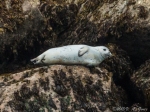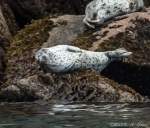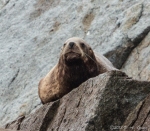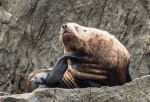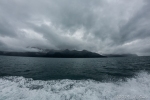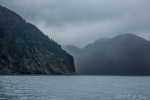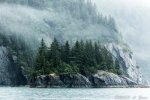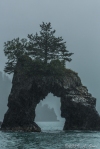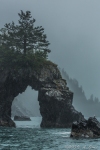Yesterday we took a Kenai Fjords tour to see the wildlife and Glaciers characteristic of the Alaskan Wilderness. I was a little disappointed in the pictures that we took as the conditions were very challenging. In photography, light exposure comes from balancing three things: f/stop, shutter speed, and ISO. If you have low light conditions, you can open the aperture by choosing a lower numbered f stop, you can choose a slower shutter speed, or you can increase your ISO making the sensor more sensitive to light. There are tradeoffs however to doing any of these. If you choose a larger aperture, you sacrifice depth of field so that not all of your subject will be in focus. If you shoot at a lower shutter speed, you will have motion blur, and if you increase ISO you introduce grain, or noise into your image which can be removed post processing, but you end up with a softer focus.
Add in the fact that the longer the lens, the less light you have to begin with, and the slower your lens or f/stop. Yesterday on the tour, we had dark skies, a lot of rain, and the motion of the boat, which created really challenging conditions. It was hard to be on the boat and look around thinking that if the sun had been shining it would have been without a doubt the most spectacular scenery on this planet. As it was, peaks and mountains were shrouded in mist, fog and clouds which have their own intrigue, but make photography nearly impossible.
So, it was an exercise in mastering bad conditions to the best of my ability, which is probably not a bad thing, except that I felt like this was a once in a lifetime opportunity, and not one that I wanted to be tested on. Still, I did the best I could, the results of which I will include in this post. We saw whales, puffins, a variety of other birds including an eagle, otters, sea lions, dolphins and seals.
The tour left the dock at 8:00, and returned at 5, and it was a very long day. We were told that the ocean swells in the gulf of Alaska were reported to be a very good day at only 6 feet. I slapped on a scope patch, a sea band, and prayed. I have a tendency to succumb to seasickness and was slightly worried that I’d be stuck on a rolling boat in heavy seas for 8 hours with no help for it. As it turns out, there was only one really bad section that lasted 30 minutes or so, and they handed out ginger candy, which helped. We ate lunch in front of the Glacier, where it rained like mad, and looked way less impressive than I had expected. The trouble with Alaska is, you lose all perspective when it comes to size. When you look at something, you think it looks big, when really it is gargantuan. Take for example a crevice that was at K2. When we asked the guide how deep it was, we guessed around 10 feet from out viewpoint. He said it was likely greater than 50 feet deep. The same holds true for Glaciers. Unless you have something to put next to it for perspective, there is no way to appreciate how big it truly is.
Back to the camera problem of light, Since we did not own a long lens, I rented one to take with me. At 400mm, I thought that would most likely be fine. Turns out for a Fjord tour, probably 500mm would have been better. The only problem with 500mm is the smallest f/stop you can get (for a reasonable price anyway) is 6.3, which does not let in enough light, especially for the conditions we encountered. The other caveat of a long lens is, handheld you would have to have a fast shutter speed such as 1/500 of a sec. which also means a higher ISO. Then your image is so full of noise, you might as well put the camera down and just forget it. So, many of my images, well, most of them, have been severely cropped.
So without talking too much more about it, I will start with the wildlife pictures:
Here are a few of the scenery pictures I was able to capture.
- Landscape around Seward
- Fishermen tagging Salmon for Yearly Fishing Contest
- Arch carved by sea water
- Birds at Whaling Site
The glacier pictures I’ve saved for last. If you look at the first one, on the left side towards the bottom, you’ll notice an arch in the ice. These occur from the melting of the ice. The hole is big enough for a boat to enter, even though it doesn’t look it. Right as we pulled in, there was a cracking sound and the glacier calved a chunk of ice from the topmost left side. The piece that came off was the size of a large home. The water was estimated to be 40 degrees, and we frequently encountered ice in the water everywhere we went. The guide estimated the height of this glacier at about 400 feet. He also said that over the years it has receded, and that where we parked the boat 20 years ago was the front face of the ice. The third picture my oldest son took with the boat in it to give perspective. The ice reflects it’s true blue color on cloudy days, and in fact only appears white in bright sunlight.
- Tunnel created by melting
- See tunnel on left, and ship on right




